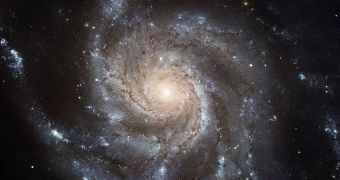New investigations are proving that the evolution of galaxies is a complex and continuous process, and one that does not conclude once a galaxy reaches a certain mass or size. The phenomenon continues over billions of years, but the way in which the cosmic structures grow differ.
Early on, when a galaxy is just forming, it most grows by accumulating material from its surroundings, or gulping up smaller, dwarf galaxies that are unfortunate enough to stray too close to it.
It does that through tidal and gravitational interactions. Given that the forming galaxy is larger than its neighbors, it can pull on the latter with more force, distorting their shapes, and eventually accumulating their material.
The inflow of hydrogen gas and cosmic dust helps spur new stellar nurseries, where massive stars begin being produced at rapid paces. At the same time, the black hole powering the galaxy accretes even more matter, growing in size.
It is believed that the Milky Way arrived at its current layout by doing this exact thing. But now, nearly 10 billion years after it first began growing, its mechanism for future expansion has somewhat subsided, Daily Galaxy reports.
However, there is no reason to believe that our galaxy will remain the same. In about four billion years, our closest galactic neighbor, Andromeda, will begin colliding with the Milky Way, in a long-term process that will most likely take tens of millions of years to complete.
The two galaxies are massive spirals. Ours has a diameter of about 100,000 light-years, while Andromeda is slightly larger. It will take a long time for all the material contained within to finally merge, but the resulting structure will most likely be a massive elliptical galaxy.
The supermassive black hole at the core of the Milky Way will increase in size even more. One particular scenario is especially advantageous for the structure, the one in which it mergers with its counterpart powering Andromeda.
If this happens, the resulting behemoth could be one of the largest ever produced in the Universe. But the overall elliptical shape of the galaxy will not necessarily result from the fact that two spirals collided to form it.
In a new study, experts propose that one of the main mechanisms through which elliptical galaxies may appear is if a stellar nursery produces a massive star cluster, which then grows by colliding and merging with dwarf galaxies.

 14 DAY TRIAL //
14 DAY TRIAL //